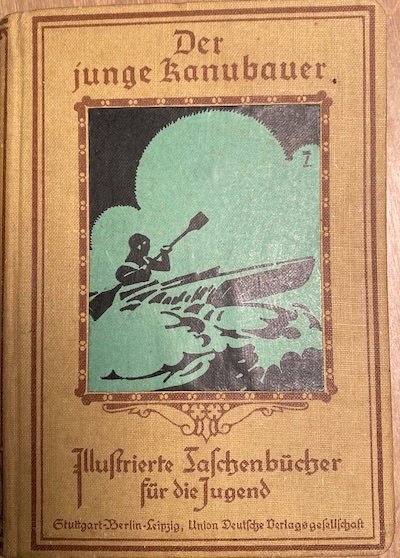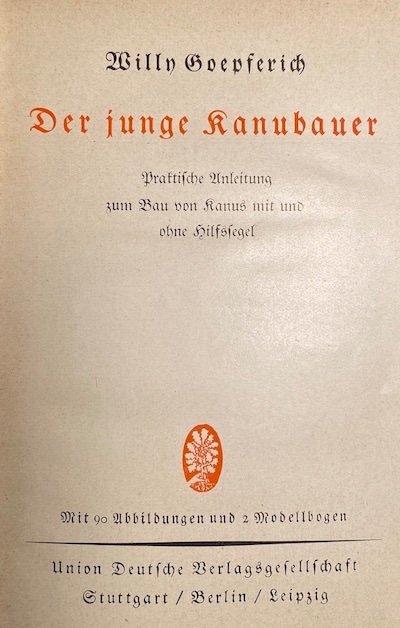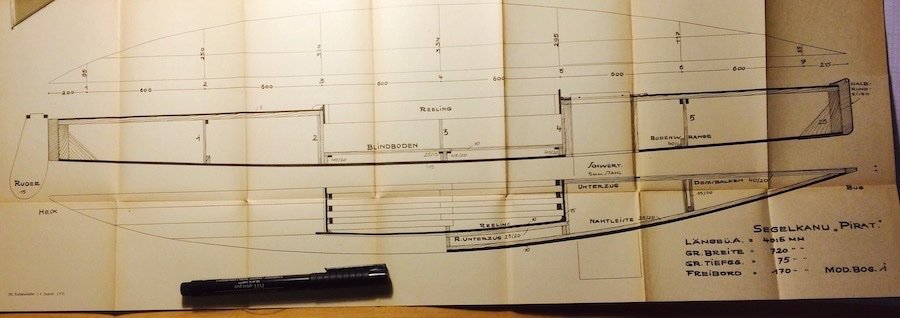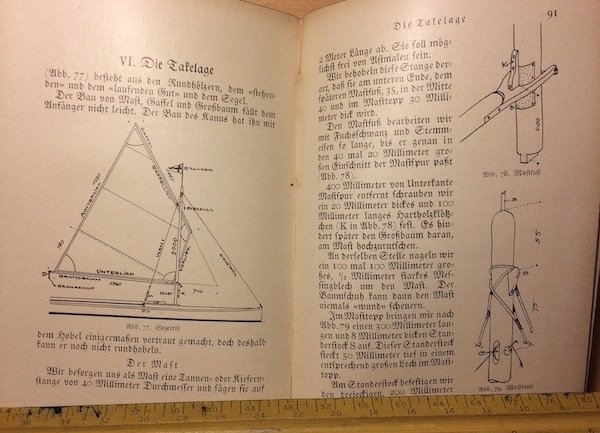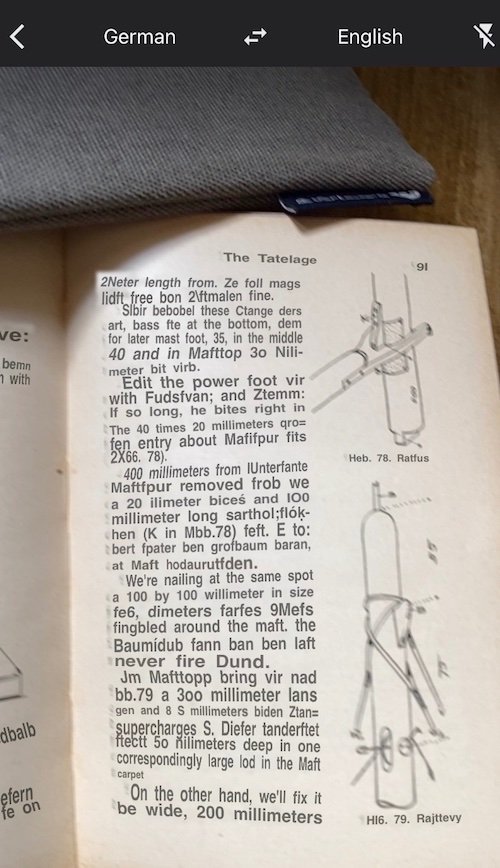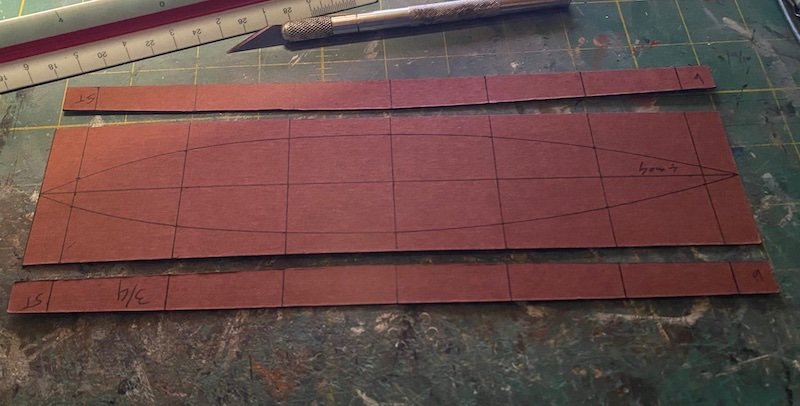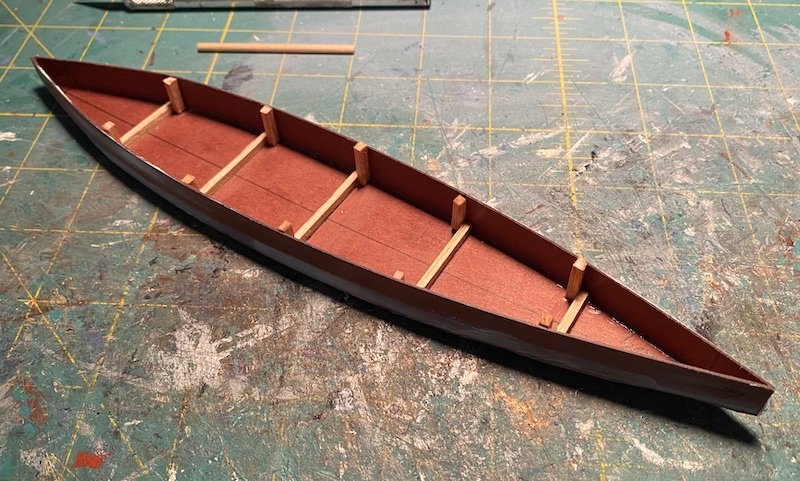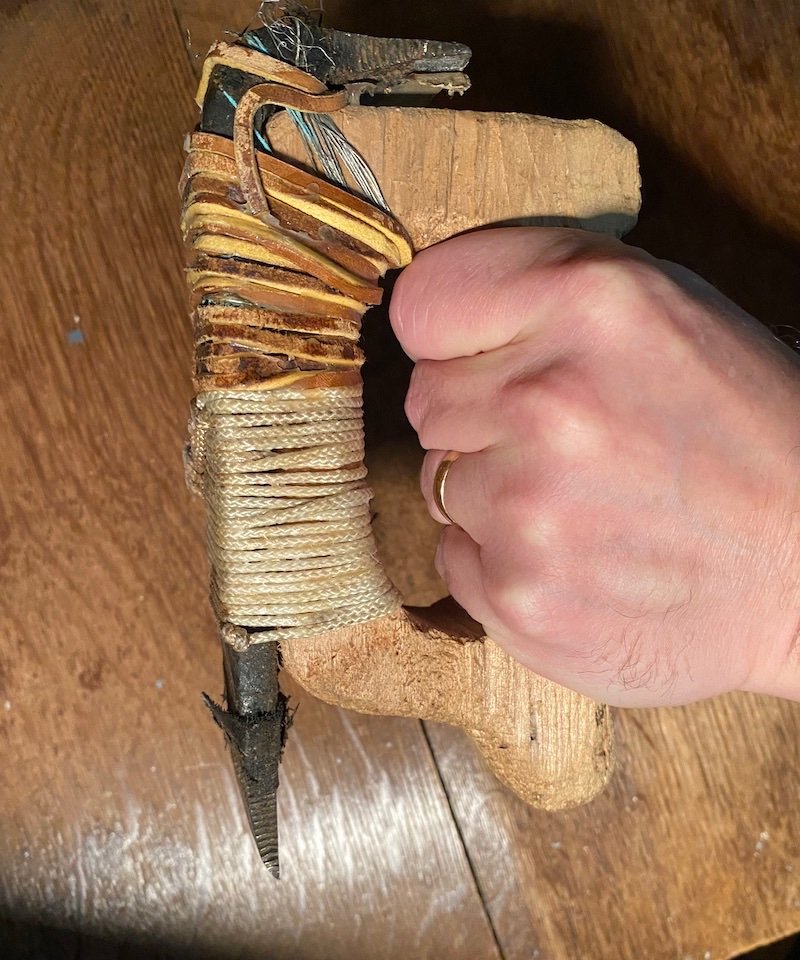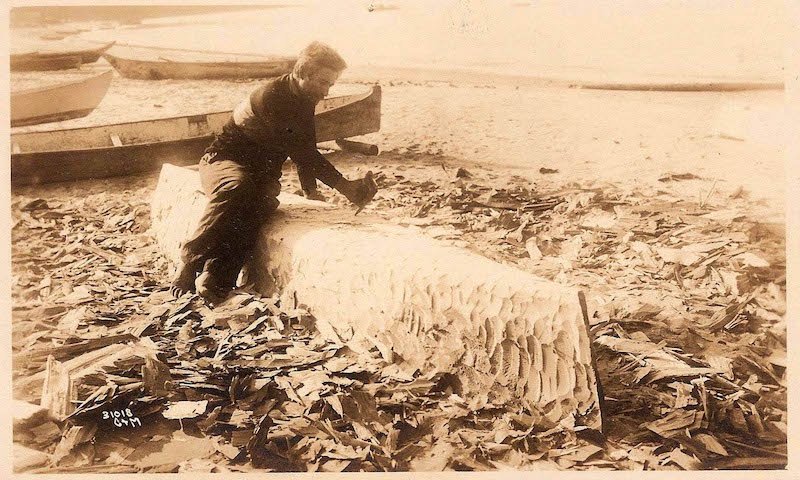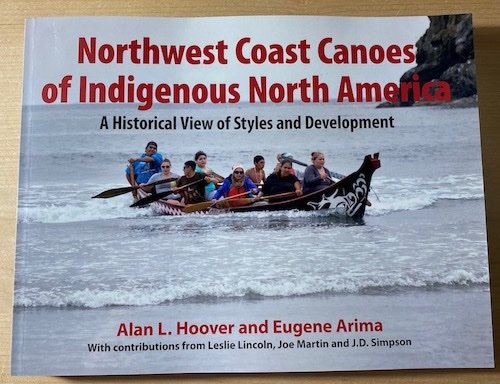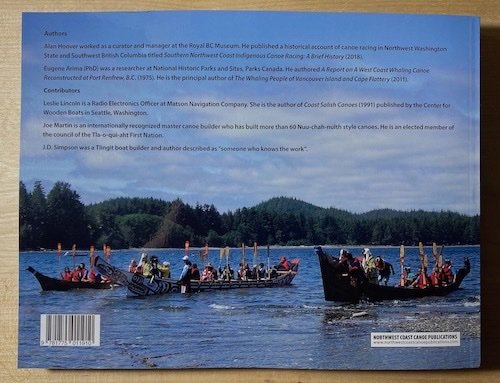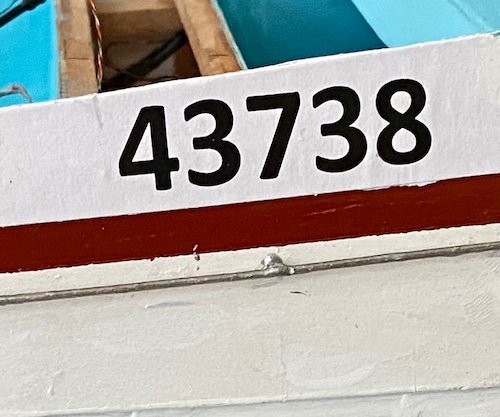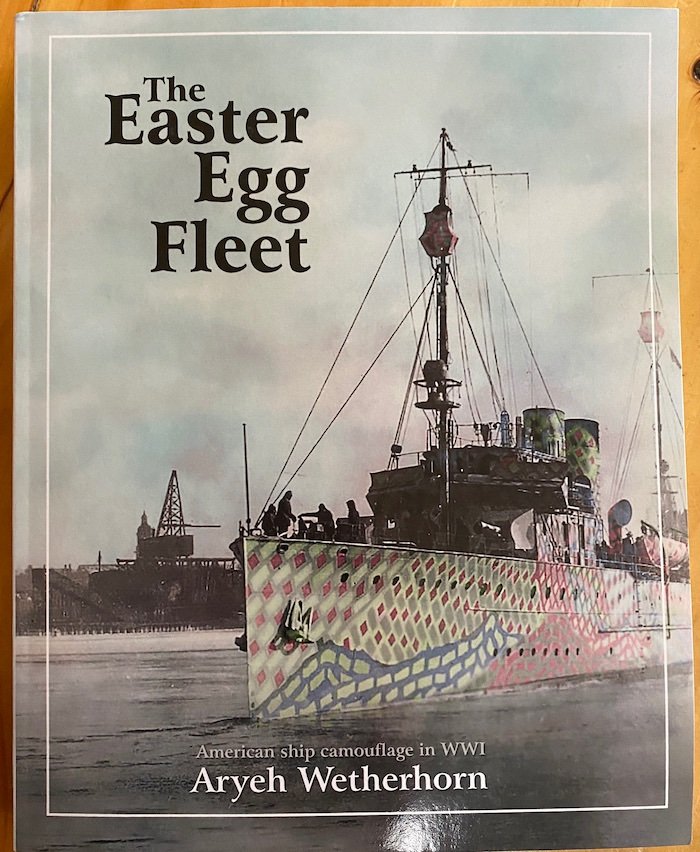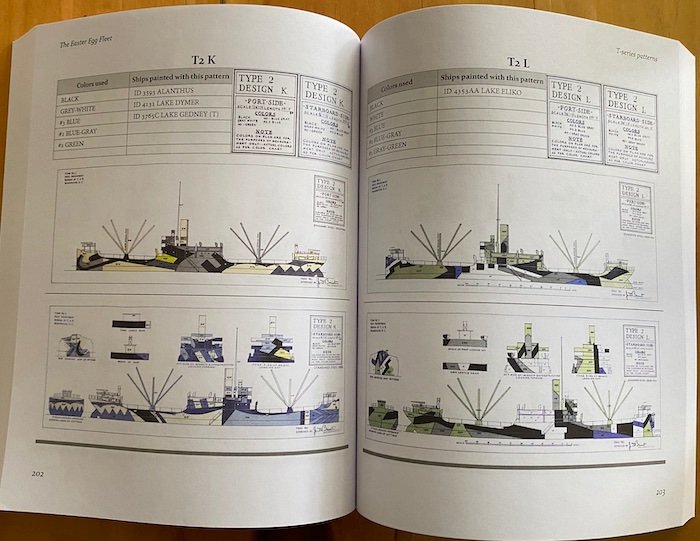-
Posts
438 -
Joined
-
Last visited
Content Type
Profiles
Forums
Gallery
Events
Everything posted by Harvey Golden
-
Thank you Wefalck-- I couldn't remember the name of it. I'd love to know the title of the book you mention, as it doesn't sound familiar. Best, Harvey
- 31 replies
-
- Sailing Canoe
- Finished
-
(and 1 more)
Tagged with:
-
I've had this book on the shelf for years, and was finally inspired to make a model of the canoe featured in it. The book, which is un-dated, comes with fold-out plans and complete instructions. I'm building it in 3/4"=1' scale, from paper and wood. First. . . the book: The canoe has a lugsail, and perhaps a little pretentiously, a forestay and shrouds. A daggerboard is used, along with a foot-steered rudder. I can't read or speak German, but fortunately, Google translate makes quick work of the text, so there won't be any issues there . . . The hull is markedly Swede-form, and has slab sides and a flat bottom. Just five molds/frames are used to build the boat. Lofting doesn't get much easier than this. I inked it right on the paper that will be the hull-- the paper is about 1/16" thick, is dense pressed, and has a very polished finish. . . anyone know what this paper is called? (I get it at the local artists' 'scrap' store.) After cutting out the panels, I glued up the five frames onto the floor panel. With this dry, I glued the side panels onto the frames, bending the bottom up at the ends so it's edges mates flush with the curve (rocker) of the side-pieces. Hmmm . . . I'm almost done!
- 31 replies
-
- Sailing Canoe
- Finished
-
(and 1 more)
Tagged with:
-

Paper on the carronades from US Navy schooner Shark 1821
Harvey Golden replied to bruce d's topic in Nautical/Naval History
Thank you for posting. Towards the bottom of the link is a photo of their exhibit at the Columbia River Maritime Museum, Astoria, Oregon. https://www.crmm.org/current-exhibits.html -

Line drawing and art - Willem van de Velde son
Harvey Golden replied to Aa-schipper's topic in Nautical/Naval History
What a lovely mix of technical and artistic representation! -

Dugout canoe build
Harvey Golden replied to reklein's topic in NAUTICAL RESEARCH GUILD - News & Information
Here's a "D" Adze-- a small hand adze commonly used historically on the Pacific Northwest Coast. I've no idea how widespread this form is, but it's superb for close controlled detail work. This example is a late 20th C. example with a large steel file blade; handle is probably Alder or W. Maple. The historic image shows on on the PNW coast used to dress a canoe hull. -

Dugout canoe build
Harvey Golden replied to reklein's topic in NAUTICAL RESEARCH GUILD - News & Information
I've used an adze a bit, and while I never came close to whacking myself with it, when one sets it down, the edge and a corner are upright, so naturally . . . I've stepped on one, with bare-feet, alas(!) Quite the trail of blood . . . -

Dugout canoe build
Harvey Golden replied to reklein's topic in NAUTICAL RESEARCH GUILD - News & Information
I think any culture that made boards from trees or did any hollowing of wood probably used adzes-- at least till they were replaced by planes and metal gouges/hollowing drawknives. With regards to Alaska, Iron (of terrestrial origin) had been traded across the Bering Straits as far back as 2,000 years ago. Any metal-fastened parts of shipwrecks that drifted ashore would've been put to good use as tools/weapons. The oceans sort of provided a pre-contact globalization of certain materials. -

Dugout canoe build
Harvey Golden replied to reklein's topic in NAUTICAL RESEARCH GUILD - News & Information
I can't speak to the relation/differences, but I believe each group (Haida/Tlingit) had several types of canoes each, used for different purposes/environments. The forms varied, but the general technology behind their creation was probably very similar. The book above covers all this in great detail as well as presents information on forms long extinct. -

Dugout canoe build
Harvey Golden replied to reklein's topic in NAUTICAL RESEARCH GUILD - News & Information
Thanks for posting this Bill! Here's a link about the project: https://www.nationalparkstraveler.org/2016/02/traditional-tlingit-dugout-canoe-being-carved-sitka-national-historical-park The NPS is doing updates just on FB so far, but no doubt on-the-water/completed pics will trickle out elsewhere in time. BTW, this superb book recently became available, written by two of the most capable scholars on the subject: -
To Jaager's list, I'd add these two volumes by Harry Sucher: "Simplified Boatbuilding: The Flat-Bottom Boat" (1973), and "Simplified Boatbuilding: The V-Bottom Boat" (1973 & 1974)-- both geared for chined craft, as their subtitles suggest. Each is a building manual with regional nuances highlighted (mostly U.S.) and each features numerous scale drawings of many types. Ed Monk's books are superb, and also Sam Rabl's "Boatbuilding in your own Backyard" (1947) would be helpful. (As an aside, I hope I'm not the only one who thinks a large bibliographical resource on boats, models, ships, etc. would be a nice thing to have here... I'd be willing to help with this.)
-
This is an area of interest of mine, too. I've sort of backed into model building having come from a few full-size (albeit small) projects; Period books (and historical retrospects) covering full-size boat building may be the best source of information for craft of this period/genre. Books on models will certainly help with many aspects of scale, approach, fittings, etc., especially if you are building solid-hulls. Best, Harvey
-

Was Howard I. Chapelle Controversial
Harvey Golden replied to SaltyNinja's topic in Nautical/Naval History
Controversies are good to explore, but we might also ask what the historic record would look like without his contributions. I certainly have issues with some of his work, yet am glad he did the work. Harvey -
No expert on this, but I'd refer you to the trove of photographic resources at https://www.navsource.org . Briefly, most seem to have been greatly reduced in size and the 3-d effect was done away with (and brought back after the war). You'll also find that it seems to have varied greatly by type/time as to the size of the numbers. I don't believe they were obscured, based on what i've seen on Navsource, and the numbers (and letters when present) were white No doubt others here know much much more. Harvey
-
Not sure if this is of any help: (Sourced from https://www.shipcamouflage.com/usn_cve.htm) They also show the Gambier Bay's scheme. (The ocean gray on the model's color chart looks a little dark.)
- 126 replies
-
- Thetis Bay
- Finished
- (and 4 more)
-
Hello Ian, Yes, Cole's book is on the shelf here, thank you! I'm sort of new 'round these parts, but if you click on my name, it might lead to pics of my models. . . . they're a very random assortment(!) All the best, Harvey
-
Welcome! I'm a big fan of West Coast fish boats, and have scratch-modeled a few (mostly Columbia River types). Look forward to seeing your projects! Best, Harvey
-
I've been wondering the same thing in recent days. Even if you match the color of the paper, the sheen, texture, precise shade is never exactly like the paint-- you learn quickly that there's a million forms of "white." In the photo, you can see the color difference between the white paper and the white paint adjacent the stripe. I have also been printing text and then going back with fine brushes to add the correct white, and then tidy up with the text color-- essentially using the printout as a pattern of sorts. I think the biggest issue might be paint wrinkling up the paper as it dries. Perhaps if you know where the text will be on the paper, just pre-paint that particular area, so you aren't working with a full page of painted paper-- I haven't tried it, but this could work. Wondering who will try it first(!) Best, Harvey
-
Dear Aryeh, Thank you for the kind comments and direction towards a good source on camouflage for ships of this period- I've just ordered your book! Yes, I had a lot of trouble with the patterns and colors for reasons you mention. I don't recall my source on the particular shades, but I think period paintings of ships were helpful, though undoubtedly a little misleading. Looking forward to reading your book-- all the best, Harvey
-

"Sand Pebbles" motor Sampan from 1966 movie
Harvey Golden replied to JRB's topic in Nautical/Naval History
I haven't watched the film through, but I'd think you might find similar vessels (though not motorized) in Worcester's "The Junks and Sampans of the Yangtze."
About us
Modelshipworld - Advancing Ship Modeling through Research
SSL Secured
Your security is important for us so this Website is SSL-Secured
NRG Mailing Address
Nautical Research Guild
237 South Lincoln Street
Westmont IL, 60559-1917
Model Ship World ® and the MSW logo are Registered Trademarks, and belong to the Nautical Research Guild (United States Patent and Trademark Office: No. 6,929,264 & No. 6,929,274, registered Dec. 20, 2022)
Helpful Links
About the NRG
If you enjoy building ship models that are historically accurate as well as beautiful, then The Nautical Research Guild (NRG) is just right for you.
The Guild is a non-profit educational organization whose mission is to “Advance Ship Modeling Through Research”. We provide support to our members in their efforts to raise the quality of their model ships.
The Nautical Research Guild has published our world-renowned quarterly magazine, The Nautical Research Journal, since 1955. The pages of the Journal are full of articles by accomplished ship modelers who show you how they create those exquisite details on their models, and by maritime historians who show you the correct details to build. The Journal is available in both print and digital editions. Go to the NRG web site (www.thenrg.org) to download a complimentary digital copy of the Journal. The NRG also publishes plan sets, books and compilations of back issues of the Journal and the former Ships in Scale and Model Ship Builder magazines.


